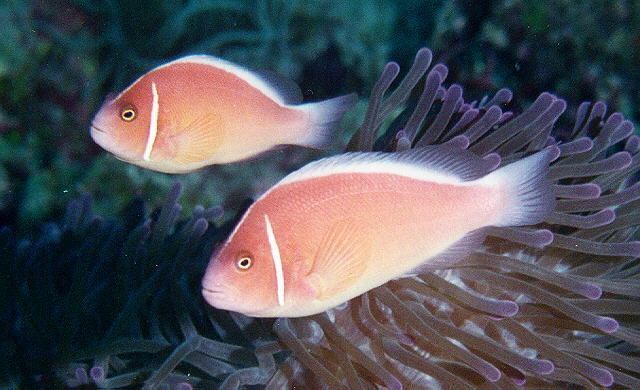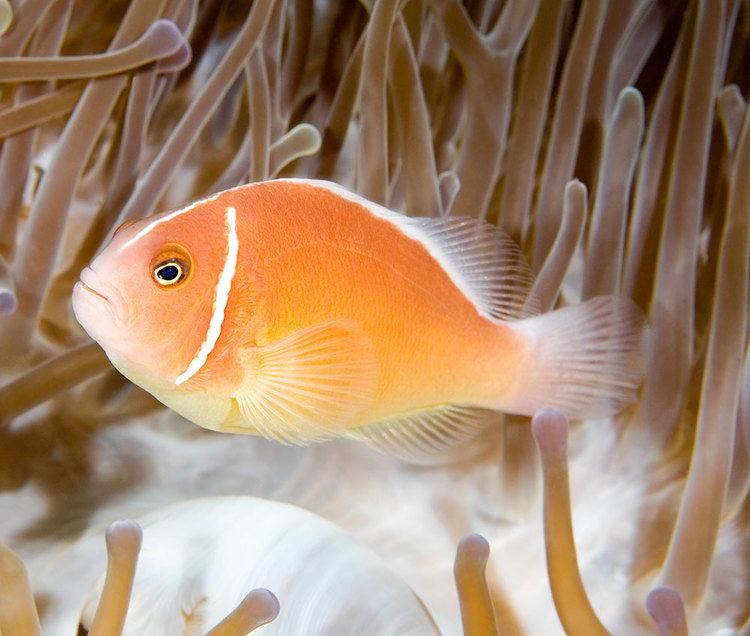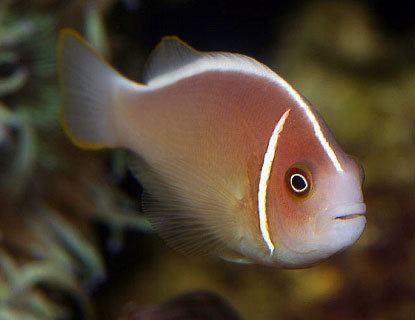Scientific name Amphiprion perideraion Higher classification Anemonefishes Order Perciformes | Superclass Osteichthyes Genus Amphiprion Phylum Chordata Rank Species | |
 | ||
Similar Clownfish, Orange skunk clownfish, Tomato clownfish, Saddleback clownfish, Maroon clownfish | ||
Spawning pink skunk clownfish
Amphiprion perideraion also known as the pink skunk clownfish or pink anemonefish, is a species of anemonefish from the skunk complex that is widespread from northern Australia through the Malay Archipelago and Melanesia. Like all anemonefishes it forms a symbiotic mutualism with sea anemones and is unaffected by the stinging tentacles of the host anemone. It is a sequential hermaphrodite with a strict sized based dominance hierarchy: the female is largest, the breeding male is second largest, and the male non-breeders get progressively smaller as the hierarchy descends. They exhibit protandry, meaning the breeding male will change to female if the sole breeding female dies, with the largest non-breeder becomes the breeding male.
Contents
- Spawning pink skunk clownfish
- Pink skunk clownfish fanning eggs
- Description
- Color variations
- Similar species
- Distribution and Habitat
- Host anemones
- Diet
- Conservation status
- In aquaria
- References

Pink skunk clownfish fanning eggs
Description

The body of A. perideraion is pink to peach. It has the white stripe along the dorsal ridge that is common to all members of the skunk complex and a white head bar running vertically just behind the eye. While the largest species of anemonefish can reach a length of 18 cm (7.1 in), A. perideraion is one of the smallest species with females growing to a length of 10 cm (3.9 in).
Color variations

Some anemonefish species have color variations based on geographic location, sex and host anemone. A. perideraion, like other members of the skunk complex, does not show any of these variations.
Similar species

A. perideraion is included in the skunk complex and so has similarities with other species in this complex. The combination of dorsal stripe and head bar distinguishes it from most other species. A. akallopisos, A. sandaracinos and A. pacificus all lack a white head bar, while A. nigripes lacks the dorsal stripe and has black belly and black pelvic and anal fins. The hybrid A. leucokranos has a broader head bar and the dorsal stripe does not extend the full length of the dorsal ridge.
Distribution and Habitat

A. perideraion is found throughout the Malay Archipelago and Melanesia, in the west Pacific Ocean from the Great Barrier Reef and Tonga, north to the Ryukyu Islands of Japan and in the eastern Indian Ocean from Ningaloo Reef, Western Australia, through the Rowley Shoals, Scott and Ashmore Reefs, Cocos and Christmas Islands to Sumatra. It inhabits reef lagoons and outer reef slopes. A. perideraion has been thought to be found at limited to depths of 3–20 m, however surveys using autonomous underwater vehicles of mesophotic reefs at Viper Reef and Hydrographers Passage in the central Great Barrier Reef observed A. perideraion at depths between 50 and 65 m. A. perideraion and A. clarkii are the only 2 anemonefish found at both the east and west coasts of Australia.
While the morphological features of A. perideraion are consistent throughout its range, genetic analysis of fish in the Indo-Malay Archipelago has shown that there is a genetic break between the Java Sea population (Karimun Java) and all other locations. There is a north to south connection of the Philippines to the rest of the archipelago and a mixing of central populations along the strong current of the Indonesian throughflow.
Host anemones
The relationship between anemonefish and their host sea anemones is not random and instead is highly nested in structure. A. perideraion is a generalist, consistent with its widespread distribution, being hosted by the following 4 out of the 10 host anemones:
Unusually for anemonefish, A. perideraion has been observed sharing a host with other species, including A. clarkii and A. akallopisos.
Diet
The natural diet of anemonefish includes zooplankton, (diatoms and copepods), benthic worms, tunicates, and algae. A. perideraion is the only species of anemonefish to primarily feed on algae.
Conservation status
Anemonefish and their host anemones are found on coral reefs and face similar environmental issues. Like corals, anemones contain intracellular endosymbionts, zooxanthellae, and can suffer from bleaching due to triggers such as increased water temperature or acidification. Local populations and genetic diversity remain vulnerable to high level of exploitation of these species and their host anemones by the global ornamental fish trade. This species was not evaluated in the 2012 release of the IUCN Red List.
In aquaria
It has successfully been bred in an aquarium. In an aquarium, hobbyists have fed the species brine shrimp, mysis shrimp, chopped shellfish, and dried algae.
